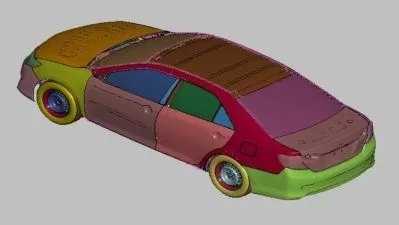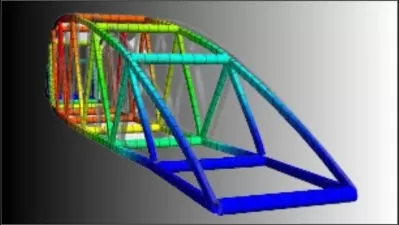Introduction to Fluent Aero package
Sijal Ahmed
52:03
Description
Use of Fluent Aero package to solve aerodynamics flow simulation in fully automatic style with minimum user interaction
What You'll Learn?
- Learning about the Aero mode in Fluent for running simulations related to aerodynamics flow analysis
- To solve ONERA M6 wing
- How to setup problem in aero mode by providing flow and geometric parameters
- Solving simulations in aero mode
- Getting CFD results for validation
Who is this for?
More details
DescriptionIn this course we will solve ONERA M6 wing using Fluent Aero. Fluent Aero is specialized software to solve aerodynamic flows. It provides the fully automatic to run different angle of attacks and range of Mach number for particular aerodynamic body without any user input. You just need to provide range of Mach number and angle of attack along with reference area, reference length, freestream pressure and temperature. Rest of the things will done by Aero features. Moreover the solver settings are optimized and set for particular flow regime which is also decided by solver by given input parameters.
Fluent Aero uses the best features from Fluent solver and solves the simulation in least iterations with utmost accuracy. Once solution is completed it provides you all input data, all aerodynamics coefficients, residuals plots in separate folder in excel format for easy plotting etc.
So we have taken ONERAÂ M6 wing and mesh was already created in other course. So we just need mesh and few boundary conditions and reference conditions and rest is done by Fluent Aero. After running solution we will take drag, lift and moment coefficient and compare it will NASAÂ data from 2018 AIAA paper (reference and paper is given in course material) . We will also compare coefficient of pressure from Fluent Aero with experimental data from AGARD and also data from NASA.
Some overview of ONERAÂ M6 test case
ONERA M6 is a classical test case for CFD validation. Although geometry is simple, but the flow field involves complex flow features such as transonic flow (Mach No. 0.7 - 0.92) with shocks, boundary layer separation etc. The ONERA M6 wing was designed in 1972 by the ONERA Aerodynamics Department as an experimental geometry for studying three-dimensional, high Reynolds number flows. ONERA is a swept back wing, with half span. It is external third of M5 Wing without twist.
Resources:
You will get following resources in this courseÂ
1. All power point slides
2. AGARD Report
3. NASAÂ paper
4. Mesh file
Who this course is for:
- Aero-engineers in the Aerospace and Defense industries
In this course we will solve ONERA M6 wing using Fluent Aero. Fluent Aero is specialized software to solve aerodynamic flows. It provides the fully automatic to run different angle of attacks and range of Mach number for particular aerodynamic body without any user input. You just need to provide range of Mach number and angle of attack along with reference area, reference length, freestream pressure and temperature. Rest of the things will done by Aero features. Moreover the solver settings are optimized and set for particular flow regime which is also decided by solver by given input parameters.
Fluent Aero uses the best features from Fluent solver and solves the simulation in least iterations with utmost accuracy. Once solution is completed it provides you all input data, all aerodynamics coefficients, residuals plots in separate folder in excel format for easy plotting etc.
So we have taken ONERAÂ M6 wing and mesh was already created in other course. So we just need mesh and few boundary conditions and reference conditions and rest is done by Fluent Aero. After running solution we will take drag, lift and moment coefficient and compare it will NASAÂ data from 2018 AIAA paper (reference and paper is given in course material) . We will also compare coefficient of pressure from Fluent Aero with experimental data from AGARD and also data from NASA.
Some overview of ONERAÂ M6 test case
ONERA M6 is a classical test case for CFD validation. Although geometry is simple, but the flow field involves complex flow features such as transonic flow (Mach No. 0.7 - 0.92) with shocks, boundary layer separation etc. The ONERA M6 wing was designed in 1972 by the ONERA Aerodynamics Department as an experimental geometry for studying three-dimensional, high Reynolds number flows. ONERA is a swept back wing, with half span. It is external third of M5 Wing without twist.
Resources:
You will get following resources in this courseÂ
1. All power point slides
2. AGARD Report
3. NASAÂ paper
4. Mesh file
Who this course is for:
- Aero-engineers in the Aerospace and Defense industries
User Reviews
Rating
Sijal Ahmed
Instructor's Courses
Udemy
View courses Udemy- language english
- Training sessions 7
- duration 52:03
- Release Date 2023/01/24











